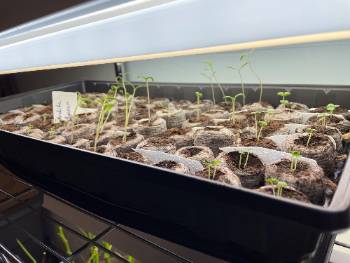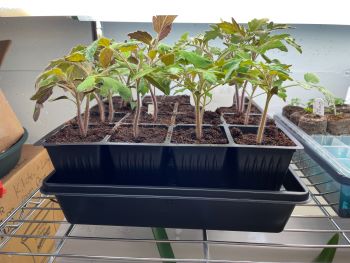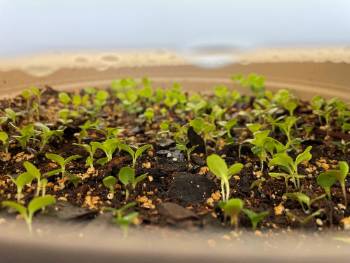Trouble Shooting Seed Starting Issues

Once your seeds have sprouted and started growing, providing enough light is key to keep your seedlings compact and growing strong. Looking closely at the photo above, you can see that my tomato seedlings have quickly outgrown the basil seedlings right next to them and have stretched slightly. This was caused by my light being too far away from the flat. To help fix this issue, I moved the light about 2-4” from the tray, and they quickly slowed their growth. To help keep the plants compact, I also changed the timer on my lights so they were on for at least 14 hours instead of the 12 I had with the rest of my tropical plants. If you continue to have issues with seedlings stretching after moving them closer to the light, you can add a fan blowing across the tray. That will slow the growth as the seedling acclimates to the airflow.

It’s amazing how quickly those seedlings can grow and change. The picture above shows the same tomato seedlings planted less than two weeks later. Once the seedlings had developed their first set of true leaves, I transplanted them from the Jiffy pellets to a larger tray. The tomatoes are the fastest growing of my seedlings, and they need more room for their roots to grow. It’s also easier to keep the light where I need it for the rest of my plants by moving the tallest plants to their tray. When you transplant seedlings, always hold them by leaves or, in my case, the peat pellets; never keep them by the stem. A seedling can regrow leaves if torn off by accident, but not if the stem is broken. You will plant most vegetables at the same depth they were growing before. I did plant my tomato seedlings a bit deeper than the peat pellet to compensate for the stretching, but the tomatoes will root along the stem, whereas other plants will not.
 Once I transplanted my tomatoes and watered them well, I fertilized them and lettuce bowls because I saw some yellowing in the leaves. I used a soluble houseplant fertilizer at the recommended rate on the label. I will continue fertilizing these babies every week or two as needed. Ideally, my transplants should be dark green with short and sturdy stems. If my seedlings continue to have a yellow tint or develop a purple hue, I must change my fertilizer schedule and fertilize more frequently. Following the recommended rates for seedlings is essential because they can be delicate and easily damaged if you overfertilize them. The rest of the seedlings will have to wait for fertilizer till after they are transplanted.
Once I transplanted my tomatoes and watered them well, I fertilized them and lettuce bowls because I saw some yellowing in the leaves. I used a soluble houseplant fertilizer at the recommended rate on the label. I will continue fertilizing these babies every week or two as needed. Ideally, my transplants should be dark green with short and sturdy stems. If my seedlings continue to have a yellow tint or develop a purple hue, I must change my fertilizer schedule and fertilize more frequently. Following the recommended rates for seedlings is essential because they can be delicate and easily damaged if you overfertilize them. The rest of the seedlings will have to wait for fertilizer till after they are transplanted.

Have questions? Contact our office where our Horticulture Extension Agent will assist you with questions.
Phone: (316) 321-9660
Email: callae@ksu.edu